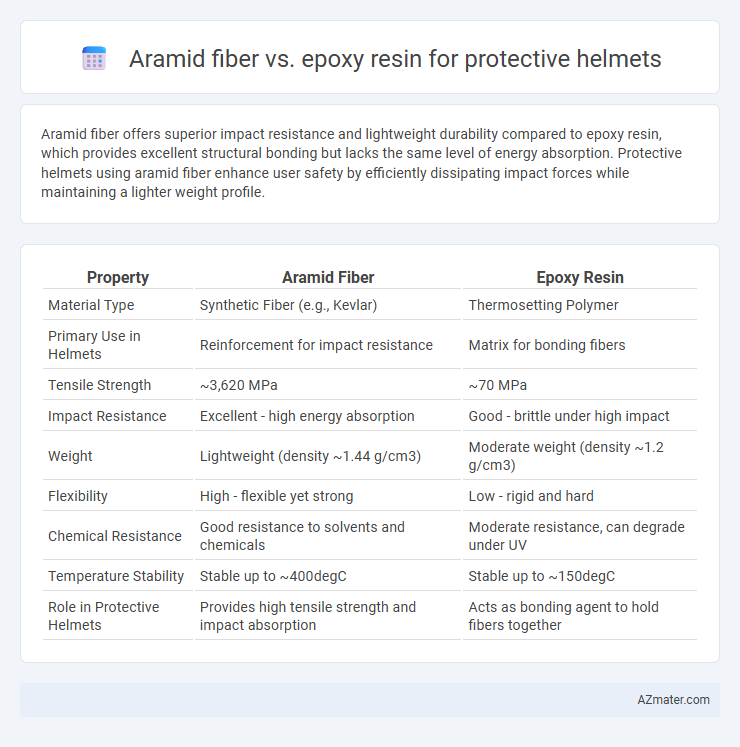Aramid fiber offers superior impact resistance and lightweight durability compared to epoxy resin, which provides excellent structural bonding but lacks the same level of energy absorption. Protective helmets using aramid fiber enhance user safety by efficiently dissipating impact forces while maintaining a lighter weight profile.
Table of Comparison
| Property | Aramid Fiber | Epoxy Resin |
|---|---|---|
| Material Type | Synthetic Fiber (e.g., Kevlar) | Thermosetting Polymer |
| Primary Use in Helmets | Reinforcement for impact resistance | Matrix for bonding fibers |
| Tensile Strength | ~3,620 MPa | ~70 MPa |
| Impact Resistance | Excellent - high energy absorption | Good - brittle under high impact |
| Weight | Lightweight (density ~1.44 g/cm3) | Moderate weight (density ~1.2 g/cm3) |
| Flexibility | High - flexible yet strong | Low - rigid and hard |
| Chemical Resistance | Good resistance to solvents and chemicals | Moderate resistance, can degrade under UV |
| Temperature Stability | Stable up to ~400degC | Stable up to ~150degC |
| Role in Protective Helmets | Provides high tensile strength and impact absorption | Acts as bonding agent to hold fibers together |
Introduction to Protective Helmet Materials
Protective helmet materials primarily include aramid fiber and epoxy resin, each offering distinct benefits to impact resistance and durability. Aramid fiber, known for its high tensile strength and lightweight properties, provides excellent ballistic protection and energy absorption in helmets. Epoxy resin acts as a durable matrix that bonds fiber layers together, enhancing helmet rigidity and overall structural integrity against impacts.
Overview of Aramid Fiber
Aramid fiber exhibits exceptional tensile strength and high impact resistance, making it a preferred material in protective helmet construction for enhanced safety and durability. Its lightweight and heat-resistant properties contribute to superior performance under extreme conditions compared to traditional materials like epoxy resin. Aramid fiber's ability to absorb and dissipate energy significantly reduces the risk of head injuries during high-impact collisions.
Key Properties of Epoxy Resin
Epoxy resin in protective helmets provides outstanding adhesive strength, chemical resistance, and excellent durability under thermal stress, making it ideal for bonding aramid fibers and enhancing structural integrity. Its high mechanical properties include superior tensile strength and impact resistance, crucial for absorbing shock and distributing force upon impact. Epoxy resin also offers low shrinkage during curing, ensuring a consistent and reliable protective layer in helmets designed for safety and performance.
Mechanical Strength Comparison
Aramid fiber exhibits exceptional tensile strength and impact resistance, making it highly effective for protective helmet shells designed to absorb and dissipate energy during collisions. Epoxy resin, while offering excellent adhesion and chemical resistance, primarily serves as a matrix material that binds reinforcing fibers like aramid, contributing to overall structural integrity but providing limited standalone mechanical strength. Combining aramid fibers with epoxy resin results in composite helmets that outperform traditional materials due to enhanced toughness, stiffness, and improved load distribution under impact conditions.
Impact Resistance Analysis
Aramid fiber composites exhibit superior impact resistance in protective helmets due to high tensile strength and energy absorption capabilities compared to epoxy resin-based materials, which tend to be more brittle under high strain rates. The molecular structure of aramid fibers, characterized by strong covalent bonds and a high degree of crystallinity, allows efficient dissipation of impact forces, reducing the risk of penetration and fracture. Epoxy resin, while providing excellent adhesion and stiffness, often lacks the flexibility required to withstand sudden impacts without cracking, making aramid fiber-reinforced helmets more reliable for impact protection.
Weight and Comfort Considerations
Aramid fiber offers exceptional strength-to-weight ratio, making protective helmets lighter and more comfortable for extended wear compared to epoxy resin-based composites, which tend to be heavier and less flexible. The lower density of aramid fibers reduces overall helmet weight, enhancing user comfort by minimizing neck strain and fatigue during prolonged use. Epoxy resin, while providing strong adhesion and structural integrity, increases the helmet's rigidity, potentially compromising comfort and reducing breathability in high-demand protective applications.
Durability and Longevity
Aramid fiber offers exceptional impact resistance and high tensile strength, making it highly durable for protective helmets subjected to repeated stress. Epoxy resin acts as a strong adhesive matrix that enhances the structural integrity and longevity of helmets by providing excellent chemical resistance and environmental stability. Combining aramid fiber with epoxy resin creates a composite material that maximizes durability and extends helmet lifespan through superior toughness and resistance to wear and degradation.
Cost Efficiency and Availability
Aramid fiber offers superior impact resistance and lightweight properties for protective helmets but comes at a higher material cost compared to epoxy resin. Epoxy resin, widely available and more affordable, often serves as a matrix material combined with fibers like aramid to enhance helmet durability while managing expenses. The cost efficiency of helmets depends on balancing aramid fiber's premium performance with epoxy resin's accessibility and affordability in manufacturing.
Safety Standards and Certifications
Aramid fiber in protective helmets offers superior impact resistance and energy absorption, meeting critical safety standards such as NIJ Level IIIA and EN 397 for industrial helmets. Epoxy resin, often used as a matrix in composite helmets, ensures structural integrity and durability while complying with certifications like DOT and ECE 22.05 for motorcycle helmets. Helmets combining aramid fiber reinforcement with epoxy resin matrices achieve enhanced protection and certification compliance across multiple safety regulations.
Conclusion: Choosing the Optimal Helmet Material
Aramid fiber offers exceptional impact resistance and lightweight durability, making it ideal for high-performance protective helmets. Epoxy resin provides strong bonding and rigidity but tends to add weight and reduce flexibility, which may affect comfort and overall protection. Selecting an optimal helmet material depends on balancing the need for strength, weight, and user comfort, with aramid fiber often preferred in advanced safety applications.

Infographic: Aramid fiber vs Epoxy resin for Protective helmet
 azmater.com
azmater.com